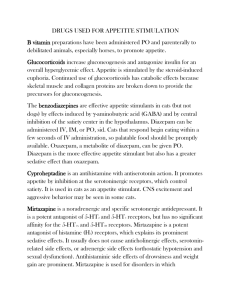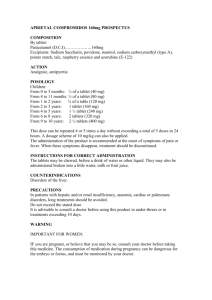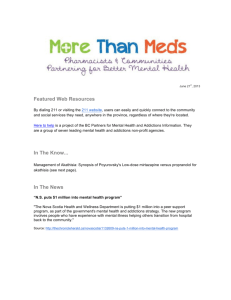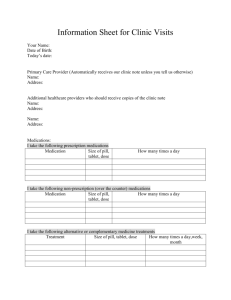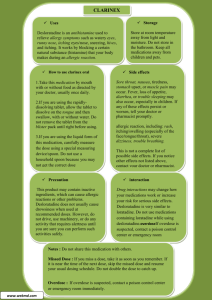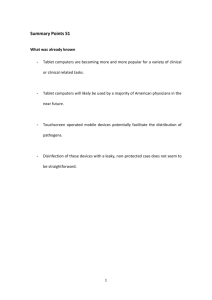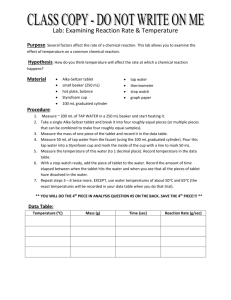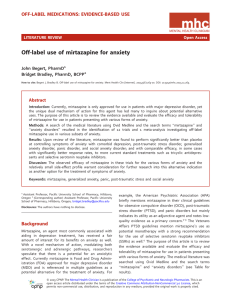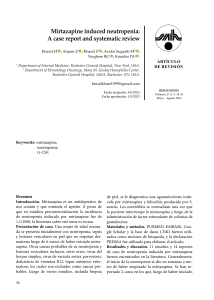REMERON SolTab - abridged clinical information
advertisement
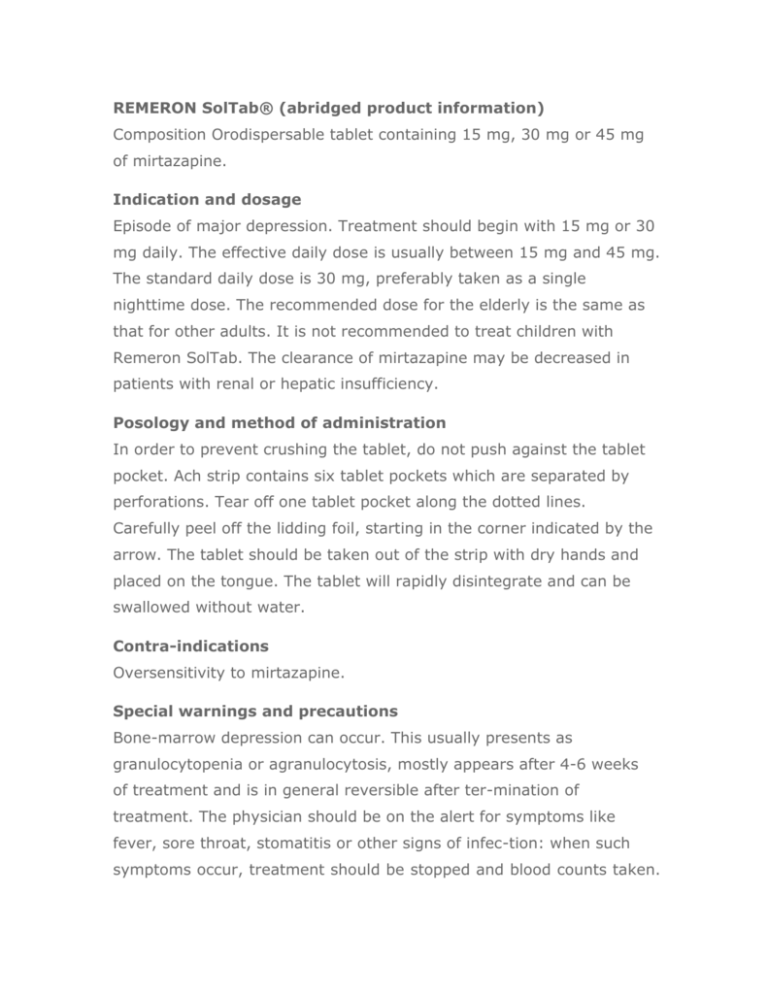
REMERON SolTab® (abridged product information) Composition Orodispersable tablet containing 15 mg, 30 mg or 45 mg of mirtazapine. Indication and dosage Episode of major depression. Treatment should begin with 15 mg or 30 mg daily. The effective daily dose is usually between 15 mg and 45 mg. The standard daily dose is 30 mg, preferably taken as a single nighttime dose. The recommended dose for the elderly is the same as that for other adults. It is not recommended to treat children with Remeron SolTab. The clearance of mirtazapine may be decreased in patients with renal or hepatic insufficiency. Posology and method of administration In order to prevent crushing the tablet, do not push against the tablet pocket. Ach strip contains six tablet pockets which are separated by perforations. Tear off one tablet pocket along the dotted lines. Carefully peel off the lidding foil, starting in the corner indicated by the arrow. The tablet should be taken out of the strip with dry hands and placed on the tongue. The tablet will rapidly disintegrate and can be swallowed without water. Contra-indications Oversensitivity to mirtazapine. Special warnings and precautions Bone-marrow depression can occur. This usually presents as granulocytopenia or agranulocytosis, mostly appears after 4-6 weeks of treatment and is in general reversible after ter-mination of treatment. The physician should be on the alert for symptoms like fever, sore throat, stomatitis or other signs of infec-tion: when such symptoms occur, treatment should be stopped and blood counts taken. Care is needed in patients with epilepsy, organic brain syndrome, hepatic or renal insufficiency and cardiovascular diseases. See also the full prescribing information. Interactions Mirtazapine may potentiate the central nervous dampening action of alcohol and the sedative effects of benzodiazepines. Remeron should not be administered concomitantly with MAO inhibitors or within two weeks of cessation of therapy with these agents. Pregnancy and breast-feeding Insufficient clinical data are available to assess the possible effect of Remeron on human pregnancy. The use of Remeron in nursing mothers is not recommended. Driving ability Remeron may impair concentration and alertness. The performance of tasks that require alertness and good concentration, such as driving a motor vehicle or operating machinery, should be avoided. Adverse reactions The most commonly reported adverse effects during treatment with Remeron are: increase in appetite and weight gain, drowsiness / sedation (generally during the first few weeks of treatment). In rare cases the following side effects may occur: (orthostatic) hypotension, mania, convulsions, tremor, myoclonus, edema and accompanying weight gain, acute bone-marrow depression (eosinophilia, granulocyto-penia, agranulocytosis, aplastic anemia and thrombocytopenia), elevations in serum transaminase activities, exanthema. Overdose The clinical safety of Remeron after overdosing is not yet fully established. Up until now, apart from excessive sedation, no clinically relevant effects have been observed following overdose with Remeron. Cases of overdose should be treated by gastric lavage with appropriate symptomatic and supportive therapy for vital functions. Pharmacodynamic properties Mirtazapine is a centrally active presynaptic á 2 -antagonist, which increases noradrenergic neurotransmission. It also modulates central serotonin function via interaction with 5-HT 2 and 5-HT 3 receptors. The histamine H 1 -antagonistic activity of mirtazapine is responsible for its sedative properties. Mirtazapine has practically no anticholinergic activity and, at therapeutic doses, has practically no effect on the cardio-vascular system. Pharmacokinetic properties The active constituent mirtazapine is rapidly and well absorbed (bioavailability 50%), reaching peak plasma levels after about 2 hours. Binding of mirtazapine to plasma proteins is approx. 85%. The mean half-life of elimination is 20-40 hours; this is sufficient to justify oncea-day dosing. Steady state is reached after 3-4 days, after which there is no further accumulation. Mirtazapine displays linear pharmacokinetics within the recommended dose range. Mirtazapine is extensively metabolized and eliminated via the urine and feces within a few days. Major pathways of biotransformation are de-methylation and oxidation, followed by conjugation. The clearance of mirtazapine may be decreased as a result of renal or hepatic insufficiency. Excipients Core: cornstarch, hydroxypropyl cellulose, magnesium stearate, colloidal silicon dioxide, lactose. Coating layer: hydroxypropyl methylcellulose, polyethylene glycol 8000, titanium dioxide (E171), yellow iron oxide (E172); 30 mg tablets also contain red iron oxide (E172); 45 mg tablets do not contain iron oxides. Shelf life Two years if stored in a dark and dry place in the originalpackage. Manufacturer N.V. Organon, PO Box 20, 5340 BH Oss, The Netherlands. Distributor Name per country. Full prescribing information Available upon request. ®indicates trademark(s) registered in one or more countries

